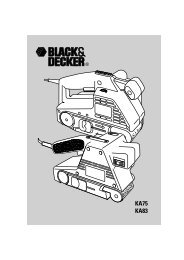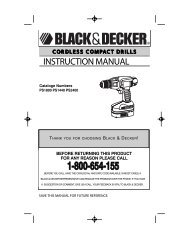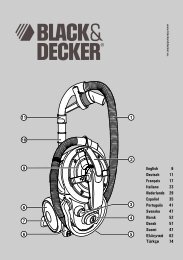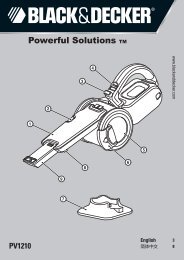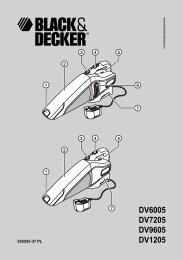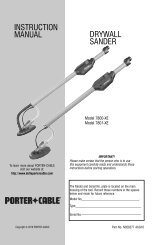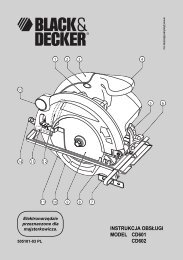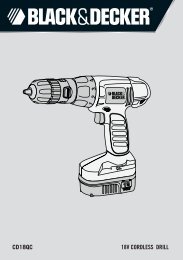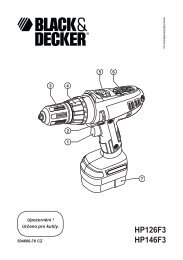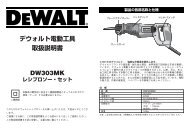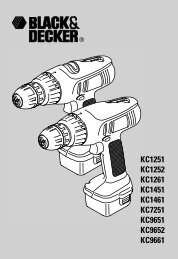Instruction Manual - Repair - Black & Decker
Instruction Manual - Repair - Black & Decker
Instruction Manual - Repair - Black & Decker
You also want an ePaper? Increase the reach of your titles
YUMPU automatically turns print PDFs into web optimized ePapers that Google loves.
3 2<br />
1<br />
www.blackanddecker.co.uk<br />
UK<br />
Ireland<br />
Australia<br />
New Zealand
B<br />
2<br />
7<br />
3<br />
6 4<br />
5<br />
2<br />
A<br />
C
Intended use<br />
Your <strong>Black</strong> & <strong>Decker</strong> compact screwdriver has been designed<br />
for screwdriving applications. This tool is intended for<br />
consumer use only.<br />
Safety instructions<br />
General power tool safety warnings<br />
@<br />
Warning! Read all safety warnings and all<br />
instructions. Failure to follow the warnings and<br />
instructions listed below may result in electric<br />
shock, fire and/or serious injury.<br />
Save all warnings and instructions for future reference.<br />
The term "power tool" in all of the warnings listed below refers<br />
to your mains operated (corded) power tool or battery<br />
operated (cordless) power tool.<br />
1. Work area safety<br />
a. Keep work area clean and well lit. Cluttered or dark<br />
areas invite accidents.<br />
b. Do not operate power tools in explosive atmospheres,<br />
such as in the presence of flammable liquids, gases<br />
or dust. Power tools create sparks which may ignite the<br />
dust or fumes.<br />
c. Keep children and bystanders away while operating a<br />
power tool. Distractions can cause you to lose control.<br />
2. Electrical safety<br />
a. Power tool plugs must match the outlet. Never modify<br />
the plug in any way. Do not use any adapter plugs<br />
with earthed (grounded) power tools. Unmodified plugs<br />
and matching outlets will reduce risk of electric shock.<br />
b. Avoid body contact with earthed or grounded<br />
surfaces such as pipes, radiators, ranges and<br />
refrigerators. There is an increased risk of electric shock<br />
if your body is earthed or grounded.<br />
c. Do not expose power tools to rain or wet conditions.<br />
Water entering a power tool will increase the risk of<br />
electric shock.<br />
d. Do not abuse the cord. Never use the cord for carrying,<br />
pulling or unplugging the power tool. Keep cord away<br />
from heat, oil, sharp edges or moving parts. Damaged<br />
or entangled cords increase the risk of electric shock.<br />
e. When operating a power tool outdoors, use an<br />
extension cord suitable for outdoor use. Use of a cord<br />
suitable for outdoor use reduces the risk of electric shock.<br />
f. If operating a power tool in a damp location is<br />
unavoidable, use a residual current device (RCD)<br />
protected supply. Use of an RCD reduces the risk of<br />
electric shock.<br />
ENGLISH<br />
3. Personal safety<br />
a. Stay alert, watch what you are doing and use common<br />
sense when operating a power tool. Do not use a<br />
power tool while you are tired or under the influence<br />
of drugs, alcohol or medication. A moment of inattention<br />
while operating power tools may result in serious personal<br />
injury.<br />
b. Use personal protective equipment. Always wear eye<br />
protection. Protective equipment such as dust mask,<br />
non-skid safety shoes, hard hat, or hearing protection used<br />
for appropriate conditions will reduce personal injuries.<br />
c. Prevent unintentional starting. Ensure the switch is in<br />
the off-position before connecting to power source<br />
and/or battery pack, picking up or carrying the tool.<br />
Carrying power tools with your finger on the switch or<br />
energising power tools that have the switch on invites<br />
accidents.<br />
d. Remove any adjusting key or wrench before turning<br />
the power tool on. A wrench or a key left attached to a<br />
rotating part of the power tool may result in personal injury.<br />
e. Do not overreach. Keep proper footing and balance at<br />
all times. This enables better control of the power tool in<br />
unexpected situations.<br />
f. Dress properly. Do not wear loose clothing or<br />
jewellery. Keep your hair, clothing and gloves away<br />
from moving parts. Loose clothes, jewellery or long hair<br />
can be caught in moving parts.<br />
g. If devices are provided for the connection of dust<br />
extraction and collection facilities, ensure these are<br />
connected and properly used. Use of dust collection can<br />
reduce dust-related hazards.<br />
4. Power tool use and care<br />
a. Do not force the power tool. Use the correct power<br />
tool for your application. The correct power tool will do<br />
the job better and safer at the rate for which it was<br />
designed.<br />
b. Do not use the power tool if the switch does not turn it<br />
on and off. Any power tool that cannot be controlled with<br />
the switch is dangerous and must be repaired.<br />
c. Disconnect the plug from the power source and/or the<br />
battery pack from the power tool before making any<br />
adjustments, changing accessories, or storing power<br />
tools. Such preventive safety measures reduce the risk of<br />
starting the power tool accidentally.<br />
d. Store idle power tools out of the reach of children and<br />
do not allow persons unfamiliar with the power tool or<br />
these instructions to operate the power tool. Power<br />
tools are dangerous in the hands of untrained users.<br />
3
4<br />
ENGLISH<br />
e. Maintain power tools. Check for misalignment or<br />
binding of moving parts, breakage of parts and any<br />
other condition that may affect the power tools<br />
operation. If damaged, have the power tool repaired<br />
before use. Many accidents are caused by poorly<br />
maintained power tools.<br />
f. Keep cutting tools sharp and clean. Properly maintained<br />
cutting tools with sharp cutting edges are less likely to bind<br />
and are easier to control.<br />
g. Use the power tool, accessories and tool bits etc.,<br />
in accordance with these instructions, taking into<br />
account the working conditions and the work to be<br />
performed. Use of the power tool for operations different<br />
from those intended could result in a hazardous situation.<br />
5. Battery tool use and care<br />
a. Recharge only with the charger specified by the<br />
manufacturer. A charger that is suitable for one type of<br />
battery pack may create a risk of fire when used with<br />
another battery pack.<br />
b. Use power tools only with specifically designated<br />
battery packs. Use of any other battery packs may create<br />
a risk of injury and fire.<br />
c. When battery pack is not in use, keep it away from<br />
other metal objects, like paper clips, coins, keys, nails,<br />
screws, or other small metal objects, that can make a<br />
connection from one terminal to another. Shorting the<br />
battery terminals together may cause burns or a fire.<br />
d. Under abusive conditions, liquid may be ejected from<br />
the battery; avoid contact. If contact accidentally<br />
occurs, flush with water. If liquid contacts eyes,<br />
additionally seek medical help. Liquid ejected from the<br />
battery may cause irritation or burns.<br />
6. Service<br />
a. Have your power tool serviced by a qualified repair<br />
person using only identical replacement parts. This will<br />
ensure that the safety of the power tool is maintained.<br />
Additional power tool safety warnings<br />
@<br />
Warning! Additional safety warnings for<br />
screwdrivers and impact wrenches<br />
Hold power tool by insulated gripping surfaces when<br />
performing an operation where the fastener may<br />
contact hidden wiring or its own cord. Fasteners<br />
contacting a "live" wire may make exposed metal parts of<br />
the power tool "live" and shock the operator.<br />
Wear ear protectors with impact wrenches. Exposure<br />
to noise can cause hearing loss.<br />
Use auxiliary handles supplied with the tool. Loss of<br />
control can cause personal injury.<br />
Use clamps or another practical way to secure and<br />
support the workpiece to a stable platform. Holding the<br />
work by hand or against your body leaves it unstable and<br />
may lead to loss of control.<br />
Before driving fasteners into walls, floors or ceilings, check<br />
for the location of wiring and pipes.<br />
This tool is not intended for use by persons (including<br />
children) with reduced physical, sensory or mental<br />
capabilities, or lack of experience and knowledge, unless<br />
they have been given supervision or instruction<br />
concerning use of the appliance by a person responsible<br />
for their safety. Children should be supervised to ensure<br />
that they do not play with the appliance.<br />
The intended use is described in this instruction manual.<br />
The use of any accessory or attachment or performance<br />
of any operation with this tool other than those<br />
recommended in this instruction manual may present a<br />
risk of personal injury and/or damage to property.<br />
Vibration<br />
The declared vibration emission values stated in the technical<br />
data and the declaration of conformity have been measured in<br />
accordance with a standard test method provided by EN 60745<br />
and may be used for comparing one tool with another.<br />
The declared vibration emission value may also be used in a<br />
preliminary assessment of exposure.<br />
Warning! The vibration emission value during actual use of<br />
the power tool can differ from the declared value depending<br />
on the ways in which the tool is used. The vibration level may<br />
increase above the level stated.<br />
When assessing vibration exposure to determine safety<br />
measures required by 2002/44/EC to protect persons regularly<br />
using power tools in employment, an estimation of vibration<br />
exposure should consider, the actual conditions of use and the<br />
way the tool is used, including taking account of all parts of<br />
the operating cycle such as the times when the tool is<br />
switched off and when it is running idle in addition to the<br />
trigger time.<br />
Labels on tool<br />
The following pictograms are shown on the tool:<br />
: Warning! To reduce the risk of injury, the user must<br />
read the instruction manual.
Additional safety instructions for batteries and<br />
chargers<br />
Batteries<br />
Never attempt to open for any reason.<br />
Do not expose the battery to water.<br />
Do not expose the battery to heat.<br />
Do not store in locations where the temperature may<br />
exceed 40 °C.<br />
Charge only at ambient temperatures between 10 °C and<br />
40 °C.<br />
Charge only using the charger provided with the tool.<br />
When disposing of batteries, follow the instructions given<br />
in the section "Protecting the environment".<br />
Chargers<br />
Use your <strong>Black</strong> & <strong>Decker</strong> charger only to charge the<br />
battery in the tool with which it was supplied. Other<br />
batteries could burst, causing personal injury and damage.<br />
Never attempt to charge non-rechargeable batteries.<br />
Have defective cords replaced immediately.<br />
Do not expose the charger to water.<br />
Do not open the charger.<br />
Do not probe the charger.<br />
The charger is intended for indoor use only.<br />
Read the instruction manual before use.<br />
The charger automatically shuts off if the ambient<br />
temperature becomes too high. As soon as the<br />
ambient temperature has cooled down, the charger<br />
will resume operating.<br />
Charge only at ambient temperatures between<br />
10 °C and 40 °C.<br />
Charging<br />
Electrical safety<br />
# Your charger is double insulated; therefore no earth<br />
wire is required. Always check that the mains<br />
voltage corresponds to the voltage on the rating<br />
plate. Never attempt to replace the charger unit with<br />
a regular mains plug.<br />
ENGLISH<br />
If the supply cord is damaged, it must be replaced by the<br />
manufacturer or an authorised <strong>Black</strong> & <strong>Decker</strong> Service<br />
Centre in order to avoid a hazard.<br />
Features<br />
1. On/off switch<br />
2. Forward/reverse slider<br />
3. Bit holder<br />
Fig. A<br />
4. Charger<br />
5. Charger plug<br />
6. Charger connector<br />
Assembly<br />
Warning! Before assembly, remove the battery from the tool.<br />
Fitting and removing a screwdriver bit (fig. B)<br />
This tool uses screwdriver bits with a 6.35 mm (1/4")<br />
hexagonal shank.<br />
To fit a bit, insert the bit shaft into the bit holder (3).<br />
To remove a bit, pull the bit shaft out of the bit holder (3).<br />
Use<br />
Warning! Let the tool work at its own pace. Do not overload.<br />
Before first use, the battery must be charged for at least<br />
16 hours.<br />
Charging the battery (fig. A)<br />
Place the tool on the charging base (6).<br />
Insert the connector (5) into the charging base.<br />
Plug in the charger (4).<br />
Switch on at the mains.<br />
Leave the tool connected to the charger for 7 - 8 hours.<br />
The charger may hum and become warm while charging; this<br />
is normal and does not indicate a problem.<br />
Generally, a charging time of 4 hours will enable the tool to<br />
operate at an effective power level for most tasks. However,<br />
further charging for up to 8 hours could significantly increase<br />
the run time, depending on the battery and charging<br />
conditions.<br />
Before using the tool, unplug the charger and disconnect<br />
the tool from the charger.<br />
Warning! Do not use the tool while it is connected to the<br />
charger.<br />
Warning! Do not charge the battery at ambient temperatures<br />
below 4 °C or above 40 °C.<br />
5
6<br />
ENGLISH<br />
Selecting the direction of rotation (fig. C)<br />
For tightening screws, use forward (clockwise) rotation.<br />
For loosening screws use reverse (counterclockwise) rotation.<br />
- To select forward rotation, push the forward/reverse slider (2)<br />
to the forward position.<br />
- To select reverse rotation, push the forward/reverse slider (2)<br />
to the rearward position.<br />
- To lock the tool, set the forward/reverse slider into the<br />
centre position.<br />
Screwdriving (fig. C)<br />
- Select forward or reverse rotation using the forward/reverse<br />
slider (2).<br />
- To switch the tool on, press the on/off switch (1).<br />
- To switch the tool off, release the on/off switch (1).<br />
Spindle lock<br />
This tool is fitted with an automatic spindle lock so that it can<br />
be used as a normal screwdriver. Use the tool this way to<br />
loosen very tight screws or to firmly tighten screws.<br />
Hints for optimum use<br />
Always use the correct type and size of screwdriver bit.<br />
If screws are difficult to tighten, try applying a small<br />
amount of washing liquid or soap as a lubricant.<br />
Use the spindle lock to loosen very tight screws or to<br />
firmly tighten screws.<br />
Always hold the tool and screwdriver bit in a straight line<br />
with the screw.<br />
When screwing in wood, it is recommended to drill a pilot<br />
hole with a depth equal to the length of the screw. A pilot<br />
hole guides the screw and prevents splintering or<br />
distortion of the wood. For the optimum size of the pilot<br />
hole, refer to the table below.<br />
When screwing in hardwood, also drill a clearance hole<br />
with a depth equal to half the length of the screw. For the<br />
optimum size of the clearance hole, refer to the table<br />
below.<br />
Screw size Pilot hole ø Pilot hole ø Clearance hole<br />
(softwood) (hardwood)<br />
No. 6 (3.5 mm) 2.0 mm 2.5 mm 3.6 mm<br />
No. 8 (4 mm) 2.5 mm 3.0 mm 4.5 mm<br />
No. 10 (5 mm) 3.0 mm 3.5 mm 5.0 mm<br />
Accessories<br />
The performance of your tool depends on the accessory used.<br />
<strong>Black</strong> & <strong>Decker</strong> and Piranha accessories are engineered to<br />
high quality standards and designed to enhance the<br />
performance of your tool. By using these accessories you will<br />
get the very best from your tool.<br />
This tool uses screwdriver bits with a 1/4" (6.35 mm) hexagonal<br />
shank. Piranha Super-lok accessories are designed for use<br />
with this tool.<br />
Maintenance<br />
Your <strong>Black</strong> & <strong>Decker</strong> tool has been designed to operate over a<br />
long period of time with a minimum of maintenance.<br />
Continuous satisfactory operation depends upon proper tool<br />
care and regular cleaning.<br />
Your charger does not require any maintenance apart from<br />
regular cleaning.<br />
Warning! Before performing any maintenance on the tool,<br />
remove the battery from the tool. Unplug the charger before<br />
cleaning it.<br />
Regularly clean the ventilation slots in your tool and<br />
charger using a soft brush or dry cloth.<br />
Regularly clean the motor housing using a damp cloth.<br />
Do not use any abrasive or solvent-based cleaner.<br />
Protecting the environment<br />
Z<br />
Separate collection. This product must not be<br />
disposed of with normal household waste.<br />
Should you find one day that your <strong>Black</strong> & <strong>Decker</strong> product<br />
needs replacement, or if it is of no further use to you, do not<br />
dispose of it with household waste. Make this product<br />
available for separate collection.<br />
z<br />
Separate collection of used products and packaging<br />
allows materials to be recycled and used again.<br />
Re-use of recycled materials helps prevent<br />
environmental pollution and reduces the demand for<br />
raw materials.<br />
Local regulations may provide for separate collection of<br />
electrical products from the household, at municipal waste<br />
sites or by the retailer when you purchase a new product.<br />
<strong>Black</strong> & <strong>Decker</strong> provides a facility for the collection and<br />
recycling of <strong>Black</strong> & <strong>Decker</strong> products once they have reached<br />
the end of their working life. To take advantage of this service<br />
please return your product to any authorised repair agent who<br />
will collect them on our behalf.<br />
You can check the location of your nearest authorised repair<br />
agent by contacting your local <strong>Black</strong> & <strong>Decker</strong> office at the<br />
address indicated in this manual. Alternatively, a list of<br />
authorised <strong>Black</strong> & <strong>Decker</strong> repair agents and full details of our<br />
after-sales service and contacts are available on the Internet<br />
at: www.2helpU.com
Batteries<br />
<strong>Black</strong> & <strong>Decker</strong> batteries can be recharged many<br />
times. At the end of their useful life, discard batteries<br />
with due care for our environment:<br />
Run the battery down completely, then remove it from the<br />
tool.<br />
NiCd, NiMH and Li-Ion batteries are recyclable. Take them<br />
to any authorised repair agent or a local recycling station.<br />
Technical data<br />
Voltage VDC KC360H<br />
3.6<br />
No-load speed min-1 180<br />
Max. torque Nm 4.0<br />
Bit holder mm 6.35 (1/4")<br />
Battery type NiCd<br />
Capacity Ah 1.8<br />
Weight kg 0.36<br />
Charger<br />
Input voltage V AC 230<br />
Approx. charging time h 7-8<br />
Weight kg 0.25<br />
EC declaration of conformity<br />
KC360H<br />
<strong>Black</strong> & <strong>Decker</strong> declares that these products conform to:<br />
98/37/EC, EN 60745<br />
Level of sound pressure according to EN 60745:<br />
Sound pressure (L pA) 55.2 dB(A), uncertainty (K) 3 dB(A)<br />
Acoustic power (L WA) 62.2 dB(A), uncertainty (K) 3 dB(A)<br />
_<br />
Vibration total values (triax vector sum) according to<br />
EN 60745:<br />
Screwdriving without impact (a h, S) 0.284 m/s 2 ,<br />
uncertainty (K) 1.5 m/s 2<br />
Kevin Hewitt<br />
Director of Consumer Engineering<br />
Spennymoor, County Durham DL16 6JG,<br />
United Kingdom<br />
1-8-2007<br />
ENGLISH<br />
Guarantee<br />
<strong>Black</strong> & <strong>Decker</strong> is confident of the quality of its products and<br />
offers an outstanding guarantee. This guarantee statement is<br />
in addition to and in no way prejudices your statutory rights.<br />
The guarantee is valid within the territories of the Member<br />
States of the European Union and the European Free Trade<br />
Area.<br />
If a <strong>Black</strong> & <strong>Decker</strong> product becomes defective due to faulty<br />
materials, workmanship or lack of conformity, within 24<br />
months from the date of purchase, <strong>Black</strong> & <strong>Decker</strong> guarantees<br />
to replace defective parts, repair products subjected to fair<br />
wear and tear or replace such products to ensure minimum<br />
inconvenience to the customer unless:<br />
The product has been used for trade, professional or hire<br />
purposes;<br />
The product has been subjected to misuse or neglect;<br />
The product has sustained damage through foreign<br />
objects, substances or accidents;<br />
<strong>Repair</strong>s have been attempted by persons other than<br />
authorised repair agents or <strong>Black</strong> & <strong>Decker</strong> service staff.<br />
To claim on the guarantee, you will need to submit proof of<br />
purchase to the seller or an authorised repair agent. You can<br />
check the location of your nearest authorised repair agent by<br />
contacting your local <strong>Black</strong> & <strong>Decker</strong> office at the address<br />
indicated in this manual. Alternatively, a list of authorised<br />
<strong>Black</strong> & <strong>Decker</strong> repair agents and full details of our after-sales<br />
service and contacts are available on the Internet at:<br />
www.2helpU.com<br />
Please visit our website www.blackanddecker.co.uk to<br />
register your new <strong>Black</strong> & <strong>Decker</strong> product and to be kept up to<br />
date on new products and special offers. Further information<br />
on the <strong>Black</strong> & <strong>Decker</strong> brand and our range of products is<br />
available at www.blackanddecker.co.uk<br />
7
Australia<br />
<strong>Black</strong> & <strong>Decker</strong> (Australia) Pty. Ltd. Tel. 03-8720 5100<br />
20 Fletcher Road, Mooroolbark, Fax 03-9727 5940<br />
Victoria, 3138<br />
New Zealand<br />
<strong>Black</strong> & <strong>Decker</strong> Tel. +64 9 259 1133<br />
5 Te Apunga Place Fax +64 9 259 1122<br />
Mt Wellington<br />
Auckland 1060<br />
United Kingdom<br />
<strong>Black</strong> & <strong>Decker</strong> Tel. 01753 511234<br />
210 Bath Road Fax 01753 551155<br />
Slough, Berkshire SL1 3YD Helpline 01753 574277<br />
90527165 09/07<br />
8




